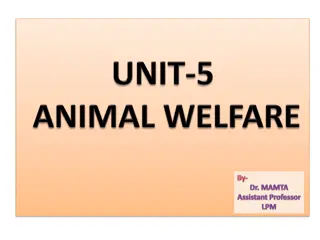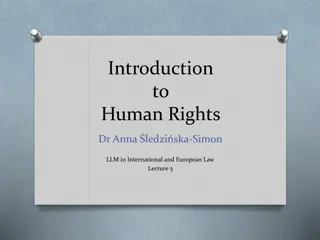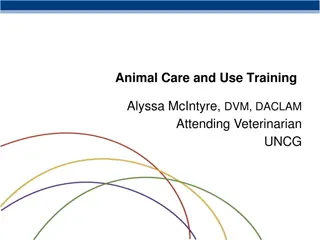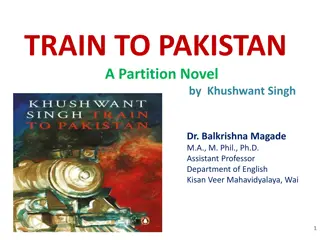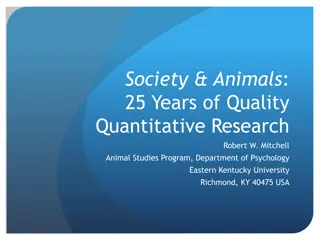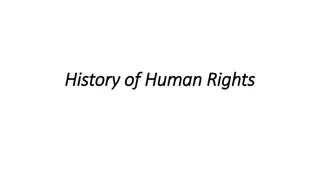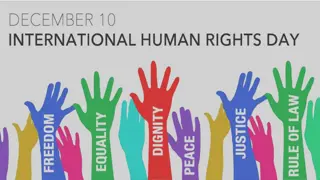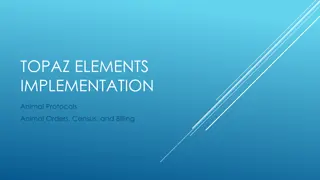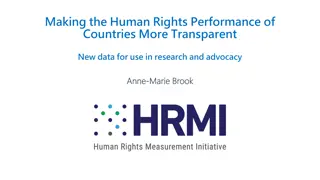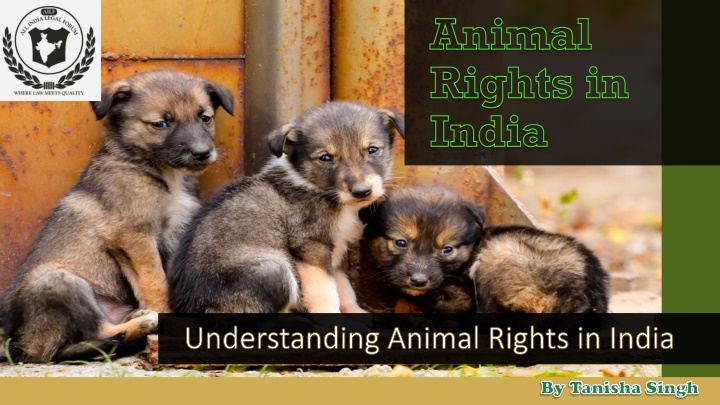
Animal Rights in India - Cases, Laws, and Progress
Explore the state of animal rights in India through documented cases of animal cruelty, existing laws like Article 51(A)(G) and Prevention of Cruelty to Animals Act, and the progress towards better animal protection as depicted in the Animal Protection Index 2020.
Download Presentation

Please find below an Image/Link to download the presentation.
The content on the website is provided AS IS for your information and personal use only. It may not be sold, licensed, or shared on other websites without obtaining consent from the author. If you encounter any issues during the download, it is possible that the publisher has removed the file from their server.
You are allowed to download the files provided on this website for personal or commercial use, subject to the condition that they are used lawfully. All files are the property of their respective owners.
The content on the website is provided AS IS for your information and personal use only. It may not be sold, licensed, or shared on other websites without obtaining consent from the author.
E N D
Presentation Transcript
Animal Rights in India Understanding Animal Rights in India Understanding Animal Rights in India By Tanisha Singh By Tanisha Singh
Cases Udaipur, 2019 Chhattisgarh, 2020 Telangana, 2020 Kerala, 2020 Hyderabad, 2020 A video of a man who tied a dog behind his car and dragged it for several metres surfaced. The man claims the dog to be dead however the video and locals allege that the dog was alive. A group of monkey used to allegedly enter a field daily. In order to scare the group away some youths grabbed hold of a monkey, took it to the field, hanged it from a tree to which it ultimately succumbed. Bodies of 45 out of 50 cows found in an old gram panchayat room. The cows allegedly died due to suffocation. They were locked up to stop them from entering the farmlands. An elephant died after consuming a pine apple filled with crackers. The 15-year elephant was 2-month pregnant. Some local gave that pineapple to it. An unidentified man burnt a kitten alive using a lighter. He posted a video on social media for the same where he can be seen filming the video while the little creature Your Logo or Name Here mewed in pain. 2
Animal Protection Index 2020 INDIA SCORED C API 2020 is released by World Animal Protection. Countries are ranked from A (Highest score) to G (Lowest score) The Index aims at showcasing where countries are doing well and where they fall short on policy and legislation. India is improving in area of Animal Protection. The current fine of Rs. 50 is not sufficient enough. Poor control over dairy system Use of animals for religious purposes and scientific research should be regulated. Your Logo or Name Here 3
Animal Protection Laws in INDIA Article 51(A)(G) Article 48 The state shall endeavor to organize agriculture and animal husbandry on modern and scientific lines and shall, in particular, take steps for preserving and improving the breeds, and prohibiting the slaughter, of cows and claves and other milch and draught cattle . In State of Gujarat v. Mirzapur Moti Kureshi Kassab Jamat(2005) Supreme Court held that Article 48 envisions a total ban on the slaughter of cows and their progeny. The article says It shall be the duty of every citizen of India to protect and improve the natural environment including forests, lakes, rivers and wildlife, and to have compassion for living creatures . In Animal Welfare Board of India v. A. Nagaraja & Ors. (The Jallikattu Case) Supreme Court said Art. 51(g) is magna carta of animal rights . Article 21 Article 48(A) The article says The state shall endeavor to protect and improve thee environment and to safeguard the forests and wildlife of the country . The article was introduced by 42nd amendment, 1976. It places an obligation on the state however it is not judicially enforceable. But it may become enforceable under the ambit of Art. 21. The article says No person shall be deprived of his life or personal liberty except according to procedure established by law . In Animal Welfare Board of India v. A. Nagaraja & Ors. (The Jallikattu Case) Supreme Court brought some animal rights under the ambit of right to life. Your Logo or Name Here 4
Animal Protection Laws in INDIA Prevention of Cruelty to Animals Act, 1960 The Wildlife Protection Act, 1972 The Prevention of Cruelty to Animals Act, 1960 was enacted to prevent the infliction of unnecessary pain or suffering on the animals. It also amended the existing Prevention of Cruelty to animals. After the enactment of this act, according to Chapter 2 of the act the Animal Board of India was formed for the promotion of animal welfare. The act makes all the activities that inflict unnecessary pain and suffering on the animal an offence like kicking, beating, overriding, overloading etc. It makes such offences punishable with a fine of Rs.10 that can extend to Rs. 50. In case of second such offence within three years the fine would increase to Rs. 25 which may extend to Rs. 100 or three months imprisonment or both. Government of India enacted Wildlife (Protection) Act 1972 with the objective to effectively protect the wild life of this country. It aims at controlling poaching, smuggling and illegal trade in wildlife and its derivatives. In 2003 the act was amended and now the punishments and penalties are more stringent. National Board for Wildlife was constituted as a statutory organization under the provisions of this act. It also provides for formation of Wildlife advisory boards, Wildlife wardens, specifies their powers and duties. It provides a comprehensive list of the endangered wildlife of the country. It provides for establishment of Wildlife centuries, national parks, zoos etc. Your Logo or Name Here 5
Government Organizations (protecting Animal Rights) Animal Welfare Board of India The Animal Welfare Board of India was established in the year 1960, under Section 4 of Prevention of Cruelty to animals Act, 1960 . It is a statutory advisory body, formed for advising the Government on animal welfare laws. It was originally formed under the Ministry of Food & Agriculture was brought under the Ministry of Environment & Forest in the year 1990. National Institute of Animal Welfare National Institute of Animal Welfare is a division of the Indian Ministry of Environment established in the year 1999 and is located in Haryana. Its objective is to create an enabling environment for fulfilling the statutory requirements as laid down in the Prevention of Cruelty to animals, 1960 . and Forests , Your Logo or Name Here 6
Non Non- -Government Organizations (NGOs) Government Organizations (NGOs) Blue Cross of India (Chennai) People for Ethical Treatment of Animals-India The Wildlife Rescue & Rehabilitation Centre Animal Aid Unlimited (Udaipur) Buddha Society for Animal Welfare Trust Group of Animal Lovers- Gujarat One of the largest animal welfare organizations in India. It was founded in 1959 and was recognized by AWBI in 1966. BSAW-Trust was established by Shiksha Ratan . They provide veterinary medical service, for the less privileged animals which are deprived of minimum essential medical aid. It is a rescue centre , a hospital and a sanctuary. It was founded in 2002. GOAL was founded by four young college friends with the thoughts and feelings with desires to do something to make a good society for PETA was founded in 2000, under the section 25 of the Companies Act, 1956. Principle- Animals are not ours to eat, wear, experiment on or use for entertainment WRRC was registered in the year 1999 as a Public Charitable Trust . The goal is equality, protection and life in freedom of all animals. It undertakes Wildlife rescue, Rehabilitation etc. There motto is Animals-It is their world Too . Your Logo or Name Here animals and birds. 7
Issues Overpopulation What ever humans do to animal in order to satiate their needs is magnified by the number of people present. Regarding them as Property- Property status leads one to treat them like non-living. There is the need to formulate and implement there individual rights. Used in Factories- Although factory farming involves many cruel practices, it isn t just those practices that are objectionable. The use of animals & animal products for food is antithetical to animal rights. Experimentation- Even law makes it legal to experiment on animals. Regardless of good it does this pain and suffering of animals should not be allowed. Killing for Money- Killing animals for fur and for other luxury is common. Used in Entertainment- Here the animals are exploited for money and entertainment purposes. They are refused natural surroundings and are forced to behave well trained. Your Logo or Name Here 8
Reason Why is cruelty against animals still a problem in India? Why are people cruel to animals? Where does the law lack? Animal cruelty, like any other form of violence , is often committed by a person who feels powerless, unnoticed or under the control of others. The motive may be to shock, threaten, intimidate or offend others or to demonstrate rejection of society s rules. Some who act cruelly copy the acts seen or done to them. Many animal related laws in our country obsolete i.e. not fit for today. One such provision is S.11 of Prevention of Cruelty to Animals, 1960 which pronounces the punishment for acts which cause unnecessary pain and suffering to animals to be Rs. 50. There are many instances of animal cruelty reported where people after torturing animals are set free after the payment of nominal fine of Rs. 50. Your Logo or Name Here 9
Measure taken In 2011, the Animal Welfare Board of India drafted a bill named Animal Welfare Act, 2011 and introduced it the parliament in order to replace the existing PCA, 1960. This bill aimed at increasing the ambit of the law. In 2014 the Animal Welfare board of India again gave a fresh draft named Animal Welfare Bill, 2014 . The bill suggested significant increase in the amount of fine charged along with several other changes. In 2016 a private members Bill was presented by MP Poonam Mahajan. The bill suggested that the Act has failed to fulfill the need of the hour. Hence according to Guidelines given by Supreme Court in Animal Welfare Board of India v. A. Nagaraj case necessary amendments in the act should be made. In 2016 several Parliamentarians and celebrities launch the NOMore50campagin . Campaign was dedicated to increase the fine under S. 11 of PCA. Many political leaders like Shashi Tharoor, Varun Gandhi were a part of this campaign. Celebrities like Usha Uthup, Sudesh Bhosle also took part. Recently on, Adv. Sankalp Golatkar has filed a PIL in Supreme Court demanding amendments in PCA, 1960. His main concern is the increased number of cases of animal cruelty animal cruelty in India. He contends that its main cause is infinitesimal penalty . Your Logo or Name Here
Courts Take People for Ethical Treatment of Animals Vs. Union of India Gauri Maulekhi Vs. Union of India and Ors In 2014, the Hon be Supreme Court banned the illegal The Bombay High Court, in 2006 passed a vital ruling, transport of cattle to Nepal for the Gadhimai festival, wherein any film meant for public viewing, in which an which played an important role in bringing down the animal is used and/or filmed, has to obtain a certificate number of animals sacrificed that year. Prior to this, from the Animal Welfare Board of India, stating that the the Sahastra Seema Bal worked with the petitioner to provisions of the Performing Animals (Registration) draft a set of regulations related to animal markets, Rules, 2001 have been duly met. This ruling safeguards cattle markets and creating infrastructure for cattle, animals from being exploited or ill-treated during the thus creating a set of recommendations that the court period of film making, which can extend across several certified. In passing the order, the Supreme Court hours. The ruling prevents animals from, among other declared that these recommendations would have to be abuses, being exposed to loud, strange sounds, beaten or adopted. kept without food and water. Your Logo or Name Here
State of U.P Vs. Mustakeem and Ors Nair, N.R. and Ors. Vs. Union of India and Ors The Kerala High Court upheld a notification by the Ministry of Environment and Forests stating that bears, monkeys, tigers, panthers and lions shall not be exhibited or trained as performing animals. When the notification was challenged in the Supreme Court, the court declared that animals suffer cruelty as they are abused and caged to make them perform, and therefore, this contravenes the PCA Act, 1960. It also dismissed the argument that the petitioners right to carry out any trade or business under article 19(g) of the Indian Constitution was violated as those activities that caused pain and suffering to the aforementioned animals would not be allowed. In the state of Uttar Pradesh, in a case where goats were found to be transported for slaughter in a cruel manner, an FIR was filed against the owner. However, the UP High Court returned custody of the animals to the owner while the matter was under litigation. On appeal, the Hon ble Supreme Court declared that the animals were supposed to be confiscated from the owner and housed in a gaushala, under the care of the state government who was given their charge for the duration of the case. With this ruling, the Court made it amply clear that once an animal was removed from a person s care on grounds of cruelty to his/her charge, the animal would not be returned until the case was resolved. Your Logo or Name Here 12
Animal Welfare Board of India vs. A Nagaraja and Others Shri. Ajay Madhusudan Marathe Vs. New Sarvodaya CHS Ltd When the Supreme Court banned the practice The Consumer Court ruled in favour of a of Jallikattu in 2014, it alluded to various resident who complained that the co-op sections of the PCA Act, 1960, which addresses society in which he resided had passed a unnecessary suffering of animals. Alluding to resolution preventing dogs from making use Section 3 and Section 11, the Hon ble Court of the building s lifts. The society passed declared that all animal fights incited by this resolution on the basis that the dog was humans are illegal, even those carried out under not a consumer and his usage of the lift the guise of tradition and culture. The Court also could result in the spread of diseases and listed various recommendations, among them an hence could be disallowed from using the overhaul of the penalties and punishments in the society s facilities. This ruling reiterated PCA Act, 1960, so as to allow it to function that residents couldn t be prevented from effectively as a deterrent in cases related to having pets and those pets were not to be animal cruelty. banned from using lifts. Your Logo or Name Here 13
Your Logo or Name Here 14 Courtesy; Fourpaws
Thank You ! Remember, Remember, The question is not, Can they reason?, nor Can they talk? The question is not, Can they reason?, nor Can they talk? But Can they suffer? But Can they suffer? - -Jeremy Bentham Jeremy Bentham







